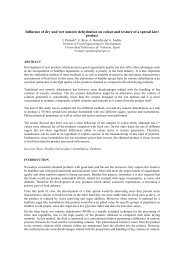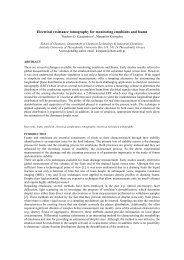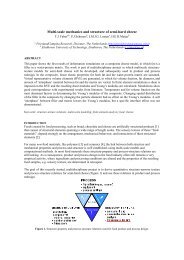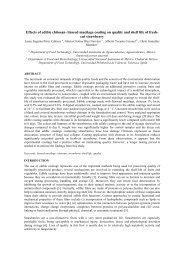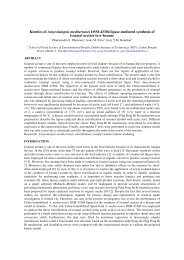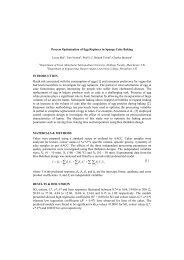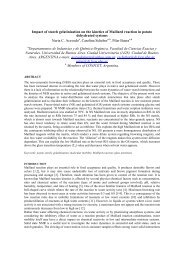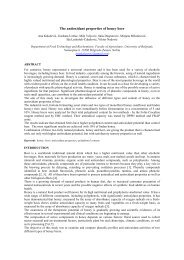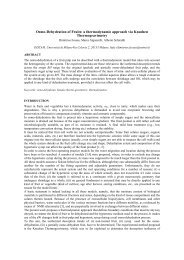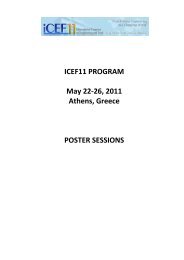Functional properties of foods. Database and model prediction
Functional properties of foods. Database and model prediction
Functional properties of foods. Database and model prediction
You also want an ePaper? Increase the reach of your titles
YUMPU automatically turns print PDFs into web optimized ePapers that Google loves.
st<strong>and</strong>ard experimental error are slightly smaller (or slightly bigger in the cases <strong>of</strong> corn starch:WPC <strong>and</strong> rice<br />
starch:SPI) than the values <strong>of</strong> the st<strong>and</strong>ard deviation between experimental <strong>and</strong> calculated values indicating<br />
that the <strong>model</strong> (Eqn. 1) is satisfactory in predicting the WAI <strong>of</strong> products. In the cases <strong>of</strong> wheat, wheat:DDG<br />
<strong>and</strong> potato:DDG the difference in the values was slightly bigger than that in the above cases showing that<br />
there is an adequate fit to the equation 1.<br />
Table 2. St<strong>and</strong>ard experimental error (Se), st<strong>and</strong>ard deviation between experimental <strong>and</strong> calculated values (Sr) <strong>and</strong> the<br />
parameters <strong>of</strong> the <strong>model</strong> for the WAI <strong>and</strong> WSI <strong>prediction</strong> respectively<br />
Property Food System Se Sr a b c d e<br />
WAI Barley cv. 0.60 1.29 4.62 -0.69 0.44 0.86 0<br />
Corn 0.42 0.69 5.23 0.07 0.16 0.35 0<br />
Oat 0.24 0.55 2.26 -0.68 -0.14 -0.06 0<br />
Rice cv. 1.12 1.21 5.97 0.09 0.60 0.01 0<br />
Wheat 0.26 1.88 4.63 -1.07 -0.46 0.46 0<br />
Beans & Chickpeas cv. 0.42 1.51 4.07 0.11 0.49 0.05 0<br />
Starch 1.08 3.06 7.54 1.23 0.91 -0.06 0<br />
Blends<br />
Corn : DDG a 0.40 0.74 0.04 0.11 -0.06 -7.46 -0.17<br />
Corn : Lentil 0.28 0.53 4.39 0.28 0.15 1.00 -0.00<br />
Rice : DDG 0.41 1.21 7.54 0.17 0.32 1.00 -0.08<br />
Wheat : DDG 0.40 1.78 4.07 -0.60 -0.13 0.34 -0.12<br />
Corn starch : WPC b 1.55 1.21 5.37 0.30 0.54 0.14 -0.08<br />
Rice starch : SPI c 1.02 0.51 19.40 0.15 -0.33 1.00 -0.29<br />
Potato : DDG 0.53 2.07 9.40 0.03 0.19 1.00 -0.12<br />
WSI Corn 5.96 11.99 19.76 -0.16 -0.34 -0.20 0<br />
Oat 0.18 1.20 6.24 -0.08 -0.51 -0.07 0<br />
Rice cv. 2.53 18.70 23.17 1.36 0.10 -0.04 0<br />
Wheat 3.34 9.96 10.42 2.57 0.02 1.45 0<br />
Beans & Chickpeas cv. 2.96 16.58 33.98 -1.48 1.12 0.26 0<br />
Starch 7.91 27.30 27.80 0.70 -0.41 -1.09 0<br />
Blends<br />
Corn : Lentil 6.23 7.57 12.76 0.52 -0.72 1.00 -0.11<br />
Corn starch : WPC d 10.00 15.48 27.18 -0.20 0.02 0.60 -0.11<br />
a Dried Distillers Grains from corn & wheat; b Whey protein concentrate; c Soy protein isolate; d Whey protein concentrate; cv: cultivar<br />
The plot, which relate the WAI (left figure) with die temperature <strong>of</strong> extruded products at X=15 % <strong>and</strong> S=180<br />
rpm are presented in figure 1. The various dots shapes represent the experimental values <strong>of</strong> materials, while<br />
the lines are calculated <strong>model</strong> values. Increase in die temperature does not have a consistent effect on<br />
experimental <strong>and</strong> predicted WAI for all raw materials examined. In the case <strong>of</strong> WSI (right figure) at X=15 %<br />
<strong>and</strong> S=200 rpm we conclude that there is not a general tendency for the various extruded materials with<br />
respect to the die temperature. Figure 2 presents typical chart <strong>of</strong> the st<strong>and</strong>ard experimental error (Se) <strong>and</strong> lack<br />
<strong>of</strong> fit (Sr) as a function <strong>of</strong> the number <strong>of</strong> parameters for WAI <strong>model</strong> in the case <strong>of</strong> rice.<br />
The confidence intervals (=0.05) for parameters <strong>of</strong> food products (data not shown), for WAI <strong>and</strong> WSI show<br />
that all the calculated parameters are required in the equation 1. The products such as wheat, beans,<br />
wheat:DDG with two or more parameters having 0 within the range <strong>of</strong> their confidence intervals are also<br />
those products where the differences in the values <strong>of</strong> Se <strong>and</strong> Sr was great. In these cases the number <strong>of</strong><br />
parameters for accurate <strong>prediction</strong> <strong>of</strong> the <strong>model</strong> may be smaller.<br />
The values <strong>of</strong> Se, Sr <strong>and</strong> parameters for PDI (Eqn. 2), obtained by curve fitting using lack <strong>of</strong> fit regression<br />
diagnostic with Levenberg–Marquardt algorithm are presented in Table 3, showing that the performance <strong>of</strong><br />
the proposed regression <strong>model</strong>, was satisfactory for the case <strong>of</strong> beans <strong>and</strong> canola meal. The results presented<br />
in Table 3 suggest that, for soy flour <strong>and</strong> soybean components, a power low nonlinear relationship between<br />
PDI <strong>and</strong> the two predictor variables (exposing temperature, corresponding residence time) is moderate; a



